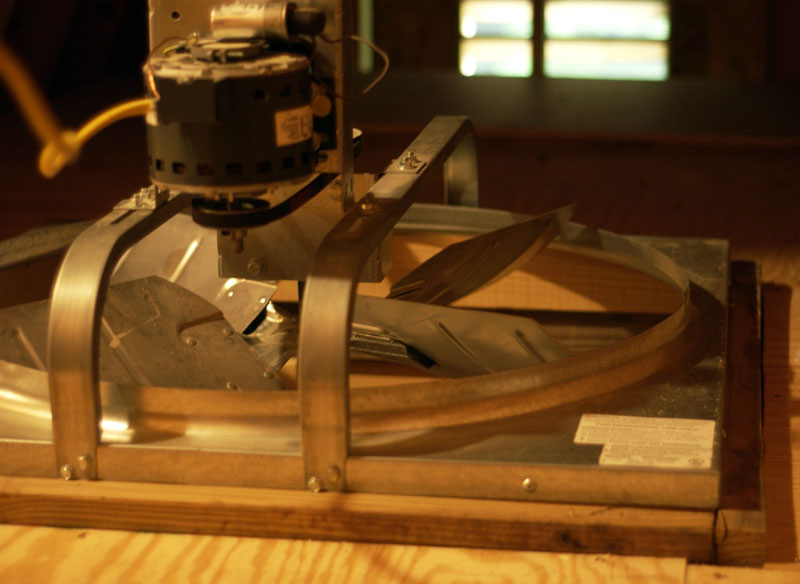
My whole-house fan, as seen from the attic
I am starting to feel optimistic that the frighteningly hot, dry, droughty weather of the past few years was abnormal, in spite of climate change. I am hoping that we are returning to more normal temperatures and levels of rainfall. When I say this, I am ignoring the clear global trend of extreme weather events. I am thinking selfishly only of this little part of the world, and of my ability to grow things here and to endure being outside in the summer without being baked to a crisp.
I suspect that La Niña was the culprit. La Niña, of course, is one extreme of a normal oscillation of water temperatures across the tropical Pacific. This oscillation still is not well understood, but it has been observed for hundreds of years. This oscillation causes a redistribution of rainfall on both sides of the Pacific. If India and Indonesia are getting more rain than normal, then here in the American southeast we are getting less. And the reverse is true.
Typically this oscillation occurs every three to seven years. Often La Niñas are 10 years apart. But since 2008, the pattern has been unusual. The La Niña of 2008 was quickly followed by another that lasted from 2010 until 2011. This La Niña ended in this past few months, and it was one of the strongest ever recorded. It was the cause of a devastating drought in Australia and probably last year’s drought in Texas as well.
Those years since 2008, unfortunately for me, were the years I’ve been working so hard to build Acorn Abbey and to get a garden, orchard, and landscape going. No wonder I have been so discouraged and exasperated at times, watching young trees die and gardens baked to a crisp.
The amount of rainfall varies greatly from spot to spot of course, especially the rainfall from thunderstorms. Thunderstorms are the source of most of the rainfall in this area during the hot part of the year. One spot can be flooded, and another spot 10 miles away can be high and dry. So I realized that I needed my own accurate rainfall record, and I started collected data on Sept. 1 of last year. Since Sept. 1, 39 inches of rain have fallen on Acorn Abbey, well on the way to equaling or exceeding the official average of 44 to 45 inches for this area. That is most encouraging.
I also am finding that, with normal weather, I need far less air conditioning at the abbey. So far this season, I have not turned the air conditioning on at all. The highest temperature we’ve had so far was about 92. The temperature in the house reaches 86 or so on a day like that, but after the sun goes down and the outdoor temperature drops, I turn on the attic fan and the indoor temperature comes back down to the upper 70s. I can live with that. But when the temperature gets above 95, I probably won’t be able to take it.
I’ve often mentioned in this blog how odd it seems that a fanciful house such as a Gothic revival cottage can be so practical. Here’s another way it’s practical: It’s livable when it’s hot outside. Actually, that was one reason I liked the design. There are lots of big windows, as with older houses. The high ceilings and large attic help. If I had large, grand shade trees — as I hope to have in 10 or 15 years — this house would be as livable in hot weather as any Southern country house of the 19th century.
A lot of the readers here are building houses, including Gothic revival cottages like mine. So I can add a few points to lessons learned after living in this house for almost three years. Large, south-facing windows are pure gold. They will warm you in the winter, and yet in the summer when the sun is overhead, they admit no direct sun at all. West-facing windows, however, are a different story. Heavy sunlight pours in on summer afternoons. You’ll want deciduous shade trees outside your west-facing windows. Lacking that, awnings would be good, though window shades are better than no protection at all.
I cringe when I look at some modern houses. The windows are tiny. Some people probably never even open them and instead rely on their heating and cooling system year-round. That would make me crazy. I like hearing the birds. And if a chicken squawks to alert me to some emergency, I can hear her.
Post a Comment